Tesco: Enhancing Employee Engagement Through Development Strategies
VerifiedAdded on 2023/06/13
|12
|3933
|329
Report
AI Summary
This report examines strategies and techniques for enhancing employee engagement within Tesco, a leading UK multinational organization. It delves into development strategies, emphasizing the importance of employee involvement in increasing organizational productivity and profitability. The report explores Maslow's Hierarchy of Needs as a motivational tool, highlighting physiological, safety, social, esteem, and self-actualization needs. It also discusses the significance of employee voices in improving organizational processes, referencing the Shannon and Weaver model of communication for effective information exchange. Furthermore, the report touches upon training and development programs as crucial components for employee growth and organizational welfare, ultimately aiming to provide a comprehensive overview of how Tesco can optimize its human resource management practices.
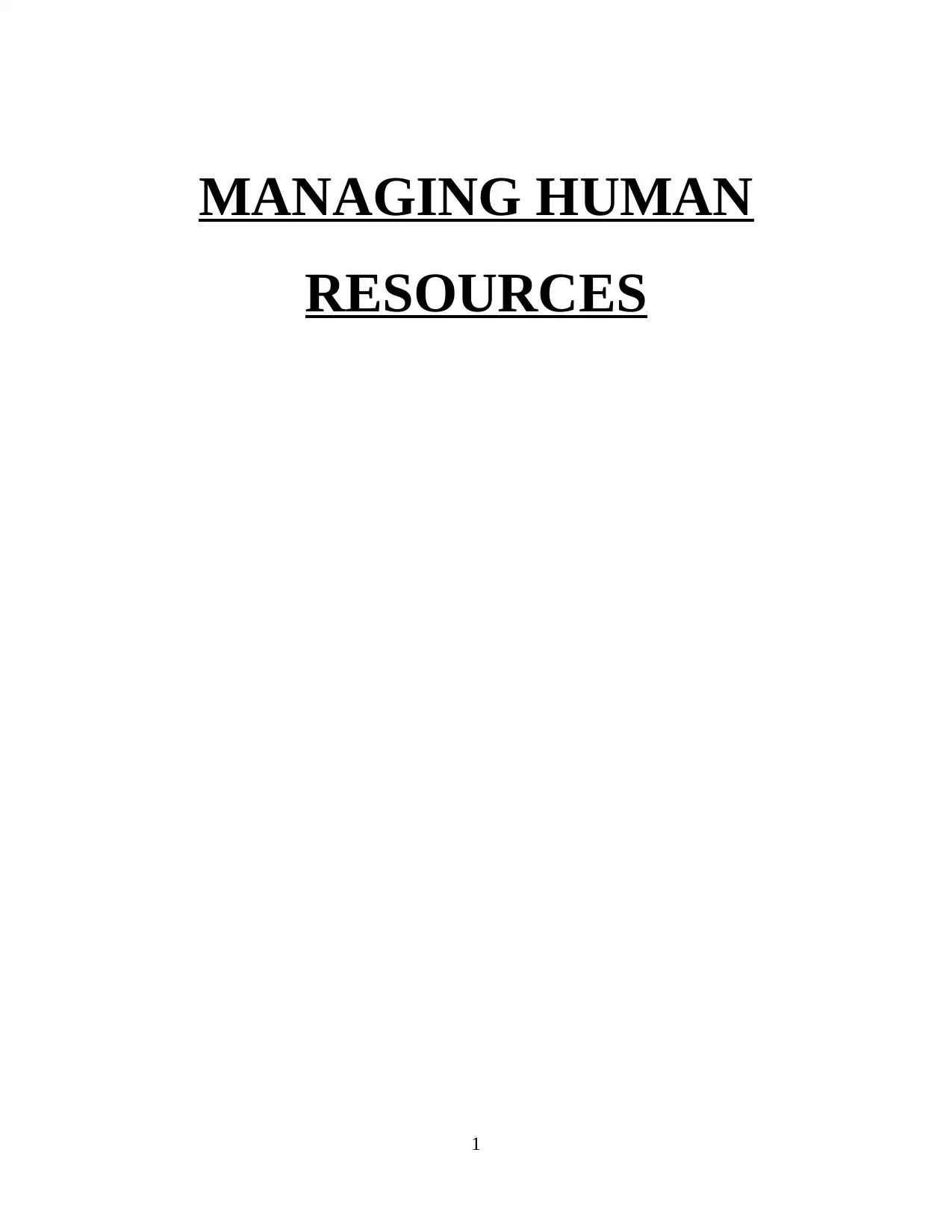
MANAGING HUMAN
RESOURCES
1
RESOURCES
1
Paraphrase This Document
Need a fresh take? Get an instant paraphrase of this document with our AI Paraphraser
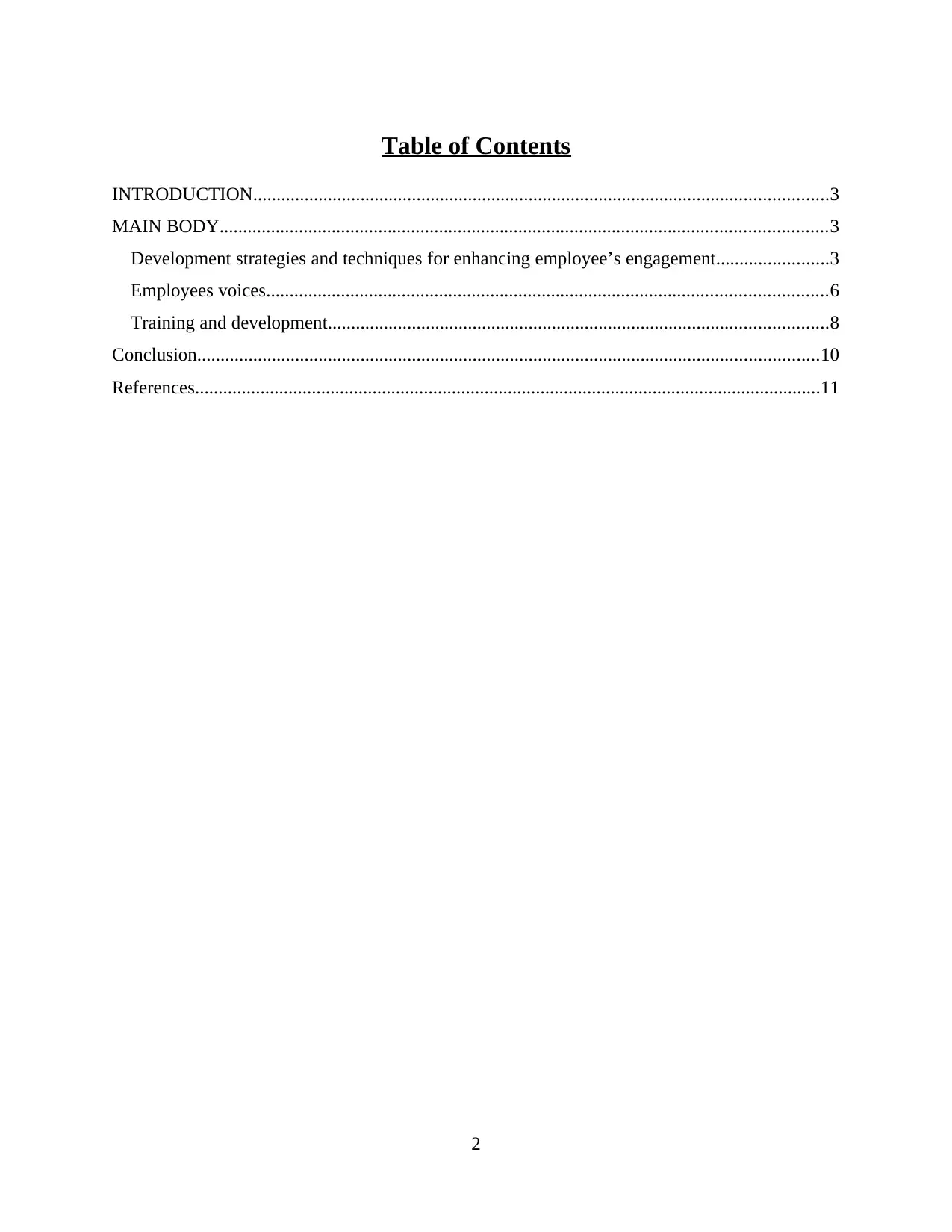
Table of Contents
INTRODUCTION...........................................................................................................................3
MAIN BODY..................................................................................................................................3
Development strategies and techniques for enhancing employee’s engagement........................3
Employees voices........................................................................................................................6
Training and development...........................................................................................................8
Conclusion.....................................................................................................................................10
References......................................................................................................................................11
2
INTRODUCTION...........................................................................................................................3
MAIN BODY..................................................................................................................................3
Development strategies and techniques for enhancing employee’s engagement........................3
Employees voices........................................................................................................................6
Training and development...........................................................................................................8
Conclusion.....................................................................................................................................10
References......................................................................................................................................11
2
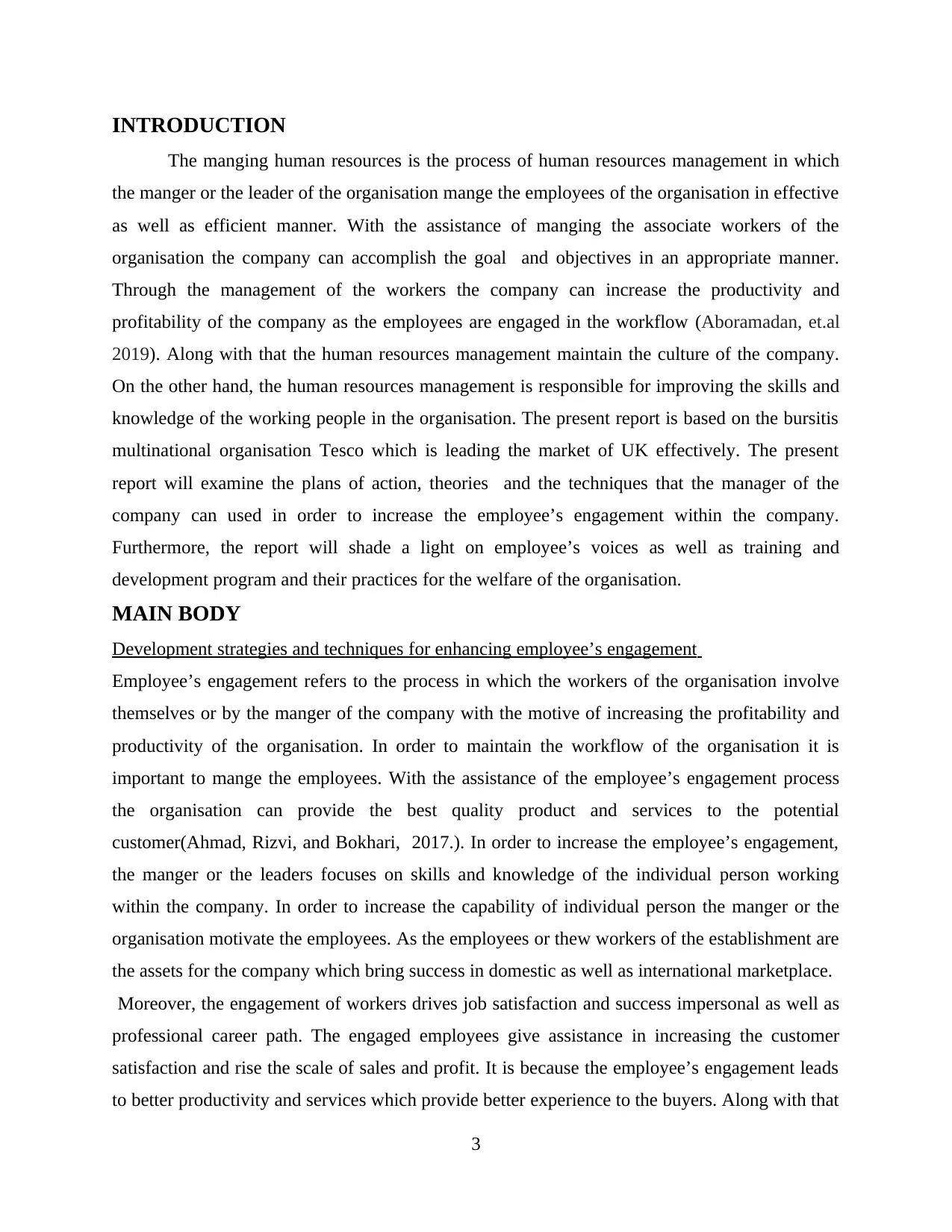
INTRODUCTION
The manging human resources is the process of human resources management in which
the manger or the leader of the organisation mange the employees of the organisation in effective
as well as efficient manner. With the assistance of manging the associate workers of the
organisation the company can accomplish the goal and objectives in an appropriate manner.
Through the management of the workers the company can increase the productivity and
profitability of the company as the employees are engaged in the workflow (Aboramadan, et.al
2019). Along with that the human resources management maintain the culture of the company.
On the other hand, the human resources management is responsible for improving the skills and
knowledge of the working people in the organisation. The present report is based on the bursitis
multinational organisation Tesco which is leading the market of UK effectively. The present
report will examine the plans of action, theories and the techniques that the manager of the
company can used in order to increase the employee’s engagement within the company.
Furthermore, the report will shade a light on employee’s voices as well as training and
development program and their practices for the welfare of the organisation.
MAIN BODY
Development strategies and techniques for enhancing employee’s engagement
Employee’s engagement refers to the process in which the workers of the organisation involve
themselves or by the manger of the company with the motive of increasing the profitability and
productivity of the organisation. In order to maintain the workflow of the organisation it is
important to mange the employees. With the assistance of the employee’s engagement process
the organisation can provide the best quality product and services to the potential
customer(Ahmad, Rizvi, and Bokhari, 2017.). In order to increase the employee’s engagement,
the manger or the leaders focuses on skills and knowledge of the individual person working
within the company. In order to increase the capability of individual person the manger or the
organisation motivate the employees. As the employees or thew workers of the establishment are
the assets for the company which bring success in domestic as well as international marketplace.
Moreover, the engagement of workers drives job satisfaction and success impersonal as well as
professional career path. The engaged employees give assistance in increasing the customer
satisfaction and rise the scale of sales and profit. It is because the employee’s engagement leads
to better productivity and services which provide better experience to the buyers. Along with that
3
The manging human resources is the process of human resources management in which
the manger or the leader of the organisation mange the employees of the organisation in effective
as well as efficient manner. With the assistance of manging the associate workers of the
organisation the company can accomplish the goal and objectives in an appropriate manner.
Through the management of the workers the company can increase the productivity and
profitability of the company as the employees are engaged in the workflow (Aboramadan, et.al
2019). Along with that the human resources management maintain the culture of the company.
On the other hand, the human resources management is responsible for improving the skills and
knowledge of the working people in the organisation. The present report is based on the bursitis
multinational organisation Tesco which is leading the market of UK effectively. The present
report will examine the plans of action, theories and the techniques that the manager of the
company can used in order to increase the employee’s engagement within the company.
Furthermore, the report will shade a light on employee’s voices as well as training and
development program and their practices for the welfare of the organisation.
MAIN BODY
Development strategies and techniques for enhancing employee’s engagement
Employee’s engagement refers to the process in which the workers of the organisation involve
themselves or by the manger of the company with the motive of increasing the profitability and
productivity of the organisation. In order to maintain the workflow of the organisation it is
important to mange the employees. With the assistance of the employee’s engagement process
the organisation can provide the best quality product and services to the potential
customer(Ahmad, Rizvi, and Bokhari, 2017.). In order to increase the employee’s engagement,
the manger or the leaders focuses on skills and knowledge of the individual person working
within the company. In order to increase the capability of individual person the manger or the
organisation motivate the employees. As the employees or thew workers of the establishment are
the assets for the company which bring success in domestic as well as international marketplace.
Moreover, the engagement of workers drives job satisfaction and success impersonal as well as
professional career path. The engaged employees give assistance in increasing the customer
satisfaction and rise the scale of sales and profit. It is because the employee’s engagement leads
to better productivity and services which provide better experience to the buyers. Along with that
3
⊘ This is a preview!⊘
Do you want full access?
Subscribe today to unlock all pages.

Trusted by 1+ million students worldwide
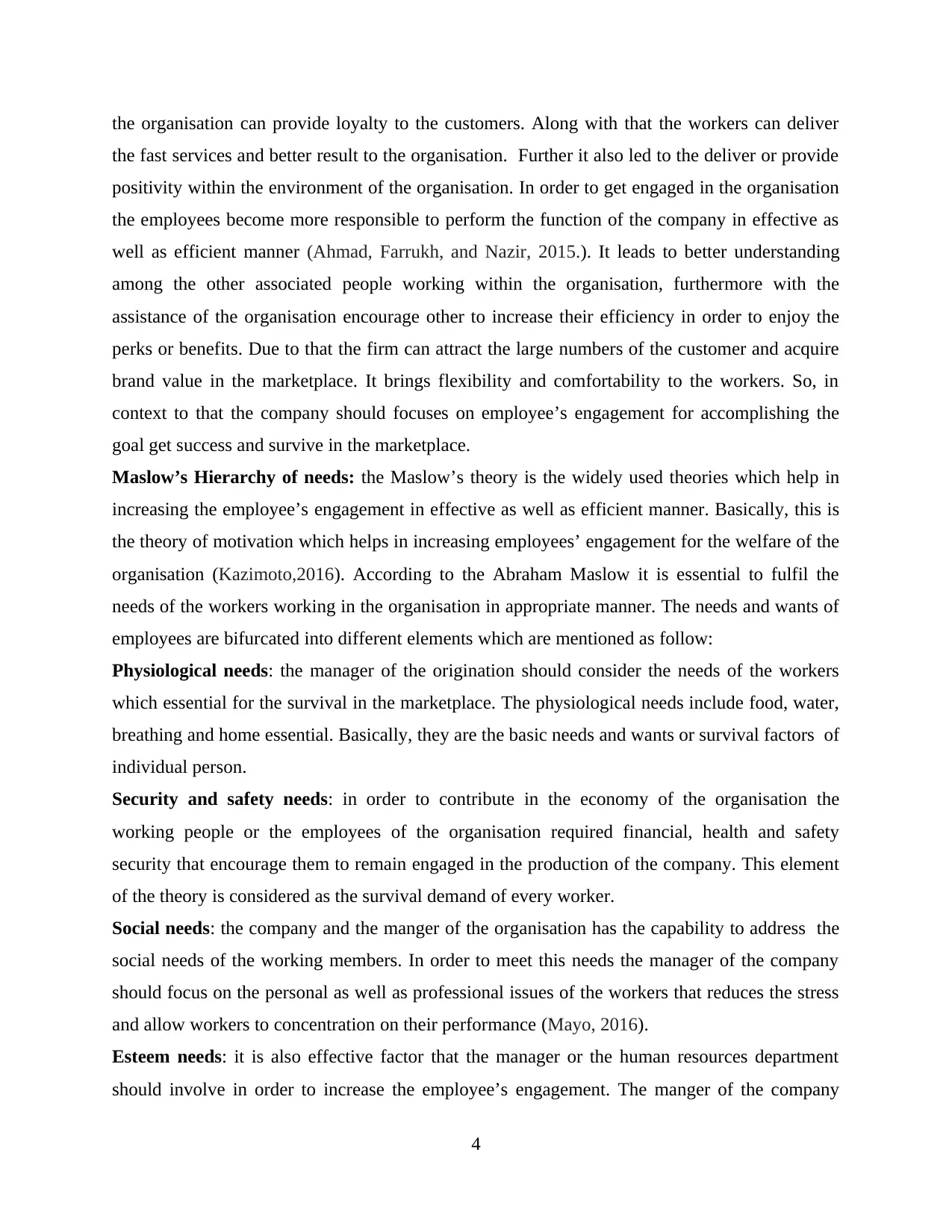
the organisation can provide loyalty to the customers. Along with that the workers can deliver
the fast services and better result to the organisation. Further it also led to the deliver or provide
positivity within the environment of the organisation. In order to get engaged in the organisation
the employees become more responsible to perform the function of the company in effective as
well as efficient manner (Ahmad, Farrukh, and Nazir, 2015.). It leads to better understanding
among the other associated people working within the organisation, furthermore with the
assistance of the organisation encourage other to increase their efficiency in order to enjoy the
perks or benefits. Due to that the firm can attract the large numbers of the customer and acquire
brand value in the marketplace. It brings flexibility and comfortability to the workers. So, in
context to that the company should focuses on employee’s engagement for accomplishing the
goal get success and survive in the marketplace.
Maslow’s Hierarchy of needs: the Maslow’s theory is the widely used theories which help in
increasing the employee’s engagement in effective as well as efficient manner. Basically, this is
the theory of motivation which helps in increasing employees’ engagement for the welfare of the
organisation (Kazimoto,2016). According to the Abraham Maslow it is essential to fulfil the
needs of the workers working in the organisation in appropriate manner. The needs and wants of
employees are bifurcated into different elements which are mentioned as follow:
Physiological needs: the manager of the origination should consider the needs of the workers
which essential for the survival in the marketplace. The physiological needs include food, water,
breathing and home essential. Basically, they are the basic needs and wants or survival factors of
individual person.
Security and safety needs: in order to contribute in the economy of the organisation the
working people or the employees of the organisation required financial, health and safety
security that encourage them to remain engaged in the production of the company. This element
of the theory is considered as the survival demand of every worker.
Social needs: the company and the manger of the organisation has the capability to address the
social needs of the working members. In order to meet this needs the manager of the company
should focus on the personal as well as professional issues of the workers that reduces the stress
and allow workers to concentration on their performance (Mayo, 2016).
Esteem needs: it is also effective factor that the manager or the human resources department
should involve in order to increase the employee’s engagement. The manger of the company
4
the fast services and better result to the organisation. Further it also led to the deliver or provide
positivity within the environment of the organisation. In order to get engaged in the organisation
the employees become more responsible to perform the function of the company in effective as
well as efficient manner (Ahmad, Farrukh, and Nazir, 2015.). It leads to better understanding
among the other associated people working within the organisation, furthermore with the
assistance of the organisation encourage other to increase their efficiency in order to enjoy the
perks or benefits. Due to that the firm can attract the large numbers of the customer and acquire
brand value in the marketplace. It brings flexibility and comfortability to the workers. So, in
context to that the company should focuses on employee’s engagement for accomplishing the
goal get success and survive in the marketplace.
Maslow’s Hierarchy of needs: the Maslow’s theory is the widely used theories which help in
increasing the employee’s engagement in effective as well as efficient manner. Basically, this is
the theory of motivation which helps in increasing employees’ engagement for the welfare of the
organisation (Kazimoto,2016). According to the Abraham Maslow it is essential to fulfil the
needs of the workers working in the organisation in appropriate manner. The needs and wants of
employees are bifurcated into different elements which are mentioned as follow:
Physiological needs: the manager of the origination should consider the needs of the workers
which essential for the survival in the marketplace. The physiological needs include food, water,
breathing and home essential. Basically, they are the basic needs and wants or survival factors of
individual person.
Security and safety needs: in order to contribute in the economy of the organisation the
working people or the employees of the organisation required financial, health and safety
security that encourage them to remain engaged in the production of the company. This element
of the theory is considered as the survival demand of every worker.
Social needs: the company and the manger of the organisation has the capability to address the
social needs of the working members. In order to meet this needs the manager of the company
should focus on the personal as well as professional issues of the workers that reduces the stress
and allow workers to concentration on their performance (Mayo, 2016).
Esteem needs: it is also effective factor that the manager or the human resources department
should involve in order to increase the employee’s engagement. The manger of the company
4
Paraphrase This Document
Need a fresh take? Get an instant paraphrase of this document with our AI Paraphraser
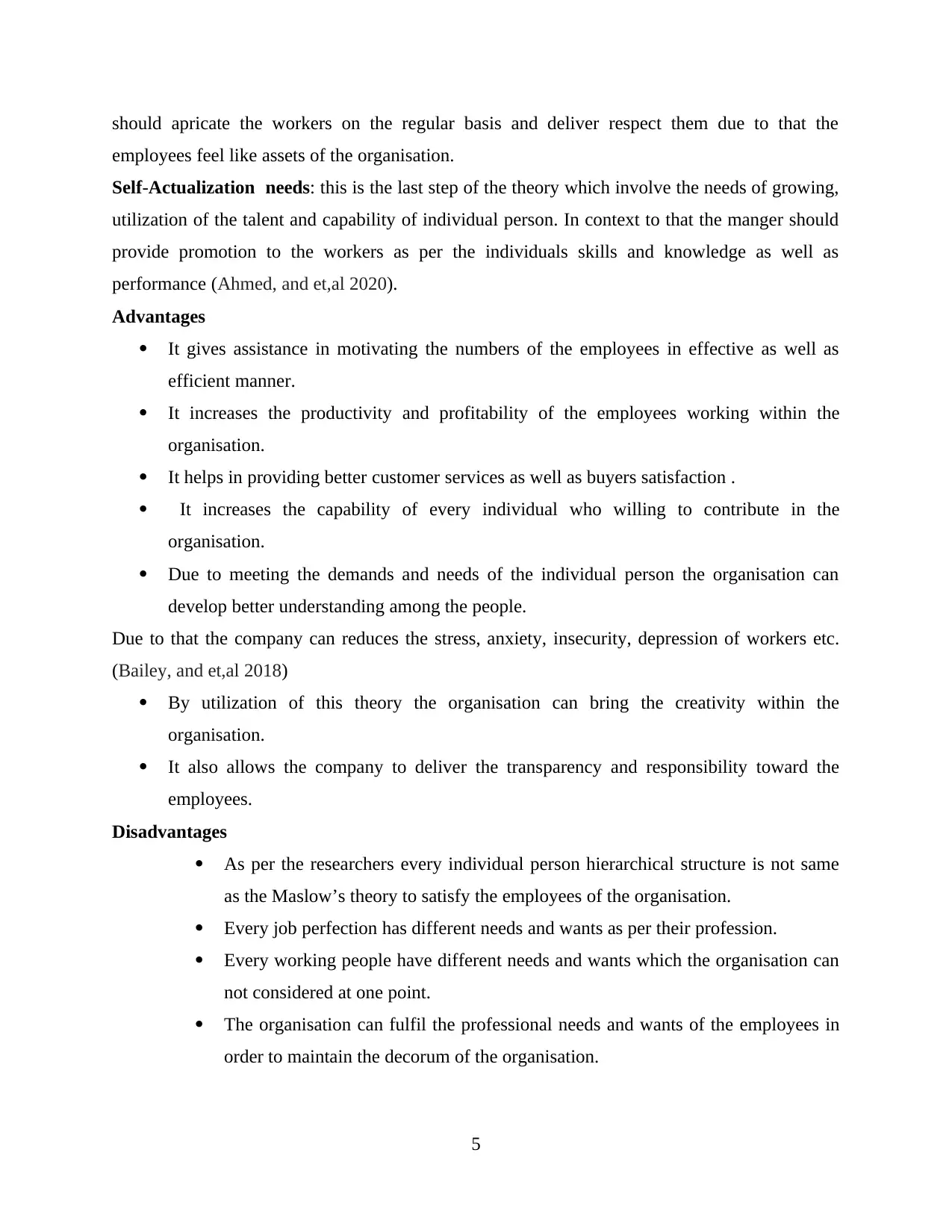
should apricate the workers on the regular basis and deliver respect them due to that the
employees feel like assets of the organisation.
Self-Actualization needs: this is the last step of the theory which involve the needs of growing,
utilization of the talent and capability of individual person. In context to that the manger should
provide promotion to the workers as per the individuals skills and knowledge as well as
performance (Ahmed, and et,al 2020).
Advantages
It gives assistance in motivating the numbers of the employees in effective as well as
efficient manner.
It increases the productivity and profitability of the employees working within the
organisation.
It helps in providing better customer services as well as buyers satisfaction .
It increases the capability of every individual who willing to contribute in the
organisation.
Due to meeting the demands and needs of the individual person the organisation can
develop better understanding among the people.
Due to that the company can reduces the stress, anxiety, insecurity, depression of workers etc.
(Bailey, and et,al 2018)
By utilization of this theory the organisation can bring the creativity within the
organisation.
It also allows the company to deliver the transparency and responsibility toward the
employees.
Disadvantages
As per the researchers every individual person hierarchical structure is not same
as the Maslow’s theory to satisfy the employees of the organisation.
Every job perfection has different needs and wants as per their profession.
Every working people have different needs and wants which the organisation can
not considered at one point.
The organisation can fulfil the professional needs and wants of the employees in
order to maintain the decorum of the organisation.
5
employees feel like assets of the organisation.
Self-Actualization needs: this is the last step of the theory which involve the needs of growing,
utilization of the talent and capability of individual person. In context to that the manger should
provide promotion to the workers as per the individuals skills and knowledge as well as
performance (Ahmed, and et,al 2020).
Advantages
It gives assistance in motivating the numbers of the employees in effective as well as
efficient manner.
It increases the productivity and profitability of the employees working within the
organisation.
It helps in providing better customer services as well as buyers satisfaction .
It increases the capability of every individual who willing to contribute in the
organisation.
Due to meeting the demands and needs of the individual person the organisation can
develop better understanding among the people.
Due to that the company can reduces the stress, anxiety, insecurity, depression of workers etc.
(Bailey, and et,al 2018)
By utilization of this theory the organisation can bring the creativity within the
organisation.
It also allows the company to deliver the transparency and responsibility toward the
employees.
Disadvantages
As per the researchers every individual person hierarchical structure is not same
as the Maslow’s theory to satisfy the employees of the organisation.
Every job perfection has different needs and wants as per their profession.
Every working people have different needs and wants which the organisation can
not considered at one point.
The organisation can fulfil the professional needs and wants of the employees in
order to maintain the decorum of the organisation.
5
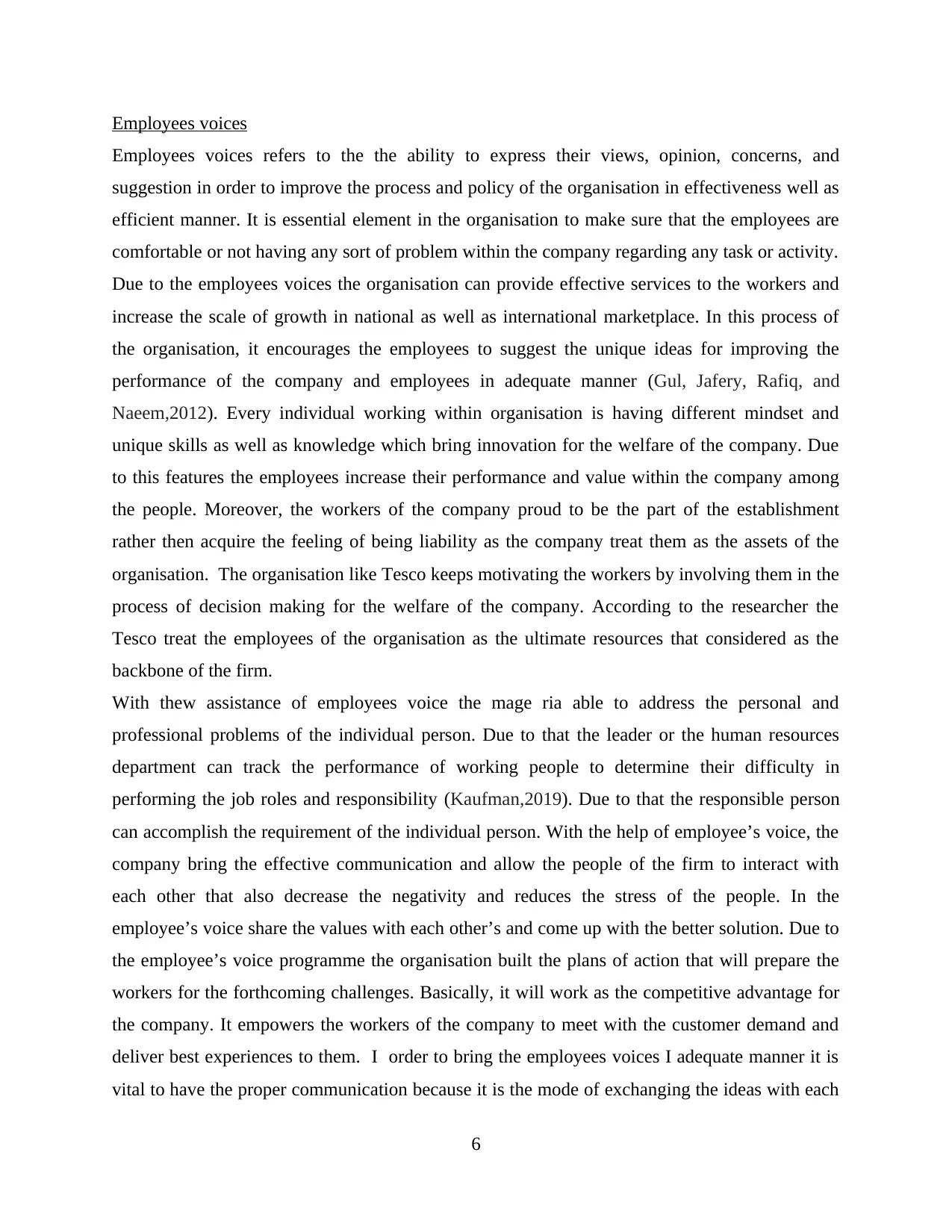
Employees voices
Employees voices refers to the the ability to express their views, opinion, concerns, and
suggestion in order to improve the process and policy of the organisation in effectiveness well as
efficient manner. It is essential element in the organisation to make sure that the employees are
comfortable or not having any sort of problem within the company regarding any task or activity.
Due to the employees voices the organisation can provide effective services to the workers and
increase the scale of growth in national as well as international marketplace. In this process of
the organisation, it encourages the employees to suggest the unique ideas for improving the
performance of the company and employees in adequate manner (Gul, Jafery, Rafiq, and
Naeem,2012). Every individual working within organisation is having different mindset and
unique skills as well as knowledge which bring innovation for the welfare of the company. Due
to this features the employees increase their performance and value within the company among
the people. Moreover, the workers of the company proud to be the part of the establishment
rather then acquire the feeling of being liability as the company treat them as the assets of the
organisation. The organisation like Tesco keeps motivating the workers by involving them in the
process of decision making for the welfare of the company. According to the researcher the
Tesco treat the employees of the organisation as the ultimate resources that considered as the
backbone of the firm.
With thew assistance of employees voice the mage ria able to address the personal and
professional problems of the individual person. Due to that the leader or the human resources
department can track the performance of working people to determine their difficulty in
performing the job roles and responsibility (Kaufman,2019). Due to that the responsible person
can accomplish the requirement of the individual person. With the help of employee’s voice, the
company bring the effective communication and allow the people of the firm to interact with
each other that also decrease the negativity and reduces the stress of the people. In the
employee’s voice share the values with each other’s and come up with the better solution. Due to
the employee’s voice programme the organisation built the plans of action that will prepare the
workers for the forthcoming challenges. Basically, it will work as the competitive advantage for
the company. It empowers the workers of the company to meet with the customer demand and
deliver best experiences to them. I order to bring the employees voices I adequate manner it is
vital to have the proper communication because it is the mode of exchanging the ideas with each
6
Employees voices refers to the the ability to express their views, opinion, concerns, and
suggestion in order to improve the process and policy of the organisation in effectiveness well as
efficient manner. It is essential element in the organisation to make sure that the employees are
comfortable or not having any sort of problem within the company regarding any task or activity.
Due to the employees voices the organisation can provide effective services to the workers and
increase the scale of growth in national as well as international marketplace. In this process of
the organisation, it encourages the employees to suggest the unique ideas for improving the
performance of the company and employees in adequate manner (Gul, Jafery, Rafiq, and
Naeem,2012). Every individual working within organisation is having different mindset and
unique skills as well as knowledge which bring innovation for the welfare of the company. Due
to this features the employees increase their performance and value within the company among
the people. Moreover, the workers of the company proud to be the part of the establishment
rather then acquire the feeling of being liability as the company treat them as the assets of the
organisation. The organisation like Tesco keeps motivating the workers by involving them in the
process of decision making for the welfare of the company. According to the researcher the
Tesco treat the employees of the organisation as the ultimate resources that considered as the
backbone of the firm.
With thew assistance of employees voice the mage ria able to address the personal and
professional problems of the individual person. Due to that the leader or the human resources
department can track the performance of working people to determine their difficulty in
performing the job roles and responsibility (Kaufman,2019). Due to that the responsible person
can accomplish the requirement of the individual person. With the help of employee’s voice, the
company bring the effective communication and allow the people of the firm to interact with
each other that also decrease the negativity and reduces the stress of the people. In the
employee’s voice share the values with each other’s and come up with the better solution. Due to
the employee’s voice programme the organisation built the plans of action that will prepare the
workers for the forthcoming challenges. Basically, it will work as the competitive advantage for
the company. It empowers the workers of the company to meet with the customer demand and
deliver best experiences to them. I order to bring the employees voices I adequate manner it is
vital to have the proper communication because it is the mode of exchanging the ideas with each
6
⊘ This is a preview!⊘
Do you want full access?
Subscribe today to unlock all pages.

Trusted by 1+ million students worldwide
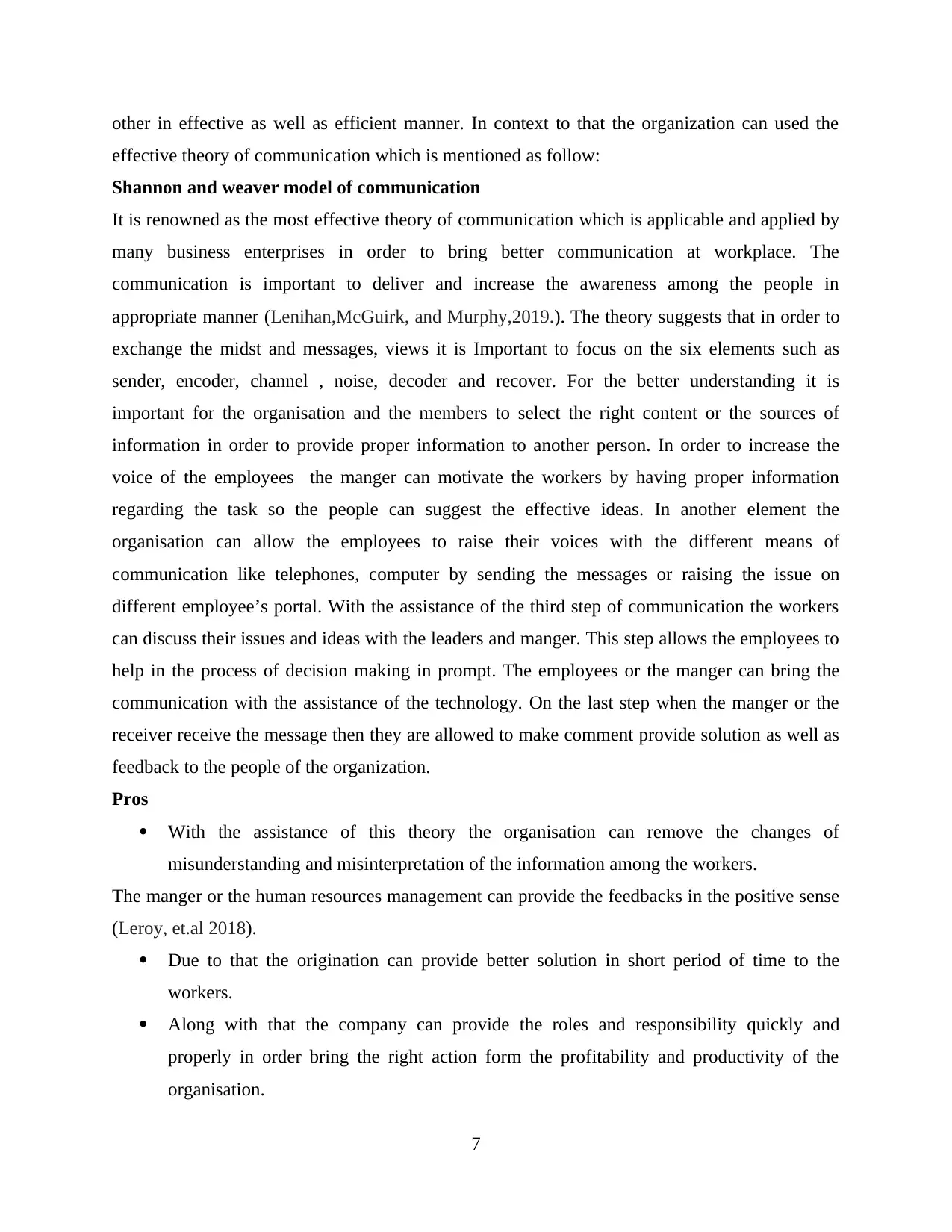
other in effective as well as efficient manner. In context to that the organization can used the
effective theory of communication which is mentioned as follow:
Shannon and weaver model of communication
It is renowned as the most effective theory of communication which is applicable and applied by
many business enterprises in order to bring better communication at workplace. The
communication is important to deliver and increase the awareness among the people in
appropriate manner (Lenihan,McGuirk, and Murphy,2019.). The theory suggests that in order to
exchange the midst and messages, views it is Important to focus on the six elements such as
sender, encoder, channel , noise, decoder and recover. For the better understanding it is
important for the organisation and the members to select the right content or the sources of
information in order to provide proper information to another person. In order to increase the
voice of the employees the manger can motivate the workers by having proper information
regarding the task so the people can suggest the effective ideas. In another element the
organisation can allow the employees to raise their voices with the different means of
communication like telephones, computer by sending the messages or raising the issue on
different employee’s portal. With the assistance of the third step of communication the workers
can discuss their issues and ideas with the leaders and manger. This step allows the employees to
help in the process of decision making in prompt. The employees or the manger can bring the
communication with the assistance of the technology. On the last step when the manger or the
receiver receive the message then they are allowed to make comment provide solution as well as
feedback to the people of the organization.
Pros
With the assistance of this theory the organisation can remove the changes of
misunderstanding and misinterpretation of the information among the workers.
The manger or the human resources management can provide the feedbacks in the positive sense
(Leroy, et.al 2018).
Due to that the origination can provide better solution in short period of time to the
workers.
Along with that the company can provide the roles and responsibility quickly and
properly in order bring the right action form the profitability and productivity of the
organisation.
7
effective theory of communication which is mentioned as follow:
Shannon and weaver model of communication
It is renowned as the most effective theory of communication which is applicable and applied by
many business enterprises in order to bring better communication at workplace. The
communication is important to deliver and increase the awareness among the people in
appropriate manner (Lenihan,McGuirk, and Murphy,2019.). The theory suggests that in order to
exchange the midst and messages, views it is Important to focus on the six elements such as
sender, encoder, channel , noise, decoder and recover. For the better understanding it is
important for the organisation and the members to select the right content or the sources of
information in order to provide proper information to another person. In order to increase the
voice of the employees the manger can motivate the workers by having proper information
regarding the task so the people can suggest the effective ideas. In another element the
organisation can allow the employees to raise their voices with the different means of
communication like telephones, computer by sending the messages or raising the issue on
different employee’s portal. With the assistance of the third step of communication the workers
can discuss their issues and ideas with the leaders and manger. This step allows the employees to
help in the process of decision making in prompt. The employees or the manger can bring the
communication with the assistance of the technology. On the last step when the manger or the
receiver receive the message then they are allowed to make comment provide solution as well as
feedback to the people of the organization.
Pros
With the assistance of this theory the organisation can remove the changes of
misunderstanding and misinterpretation of the information among the workers.
The manger or the human resources management can provide the feedbacks in the positive sense
(Leroy, et.al 2018).
Due to that the origination can provide better solution in short period of time to the
workers.
Along with that the company can provide the roles and responsibility quickly and
properly in order bring the right action form the profitability and productivity of the
organisation.
7
Paraphrase This Document
Need a fresh take? Get an instant paraphrase of this document with our AI Paraphraser
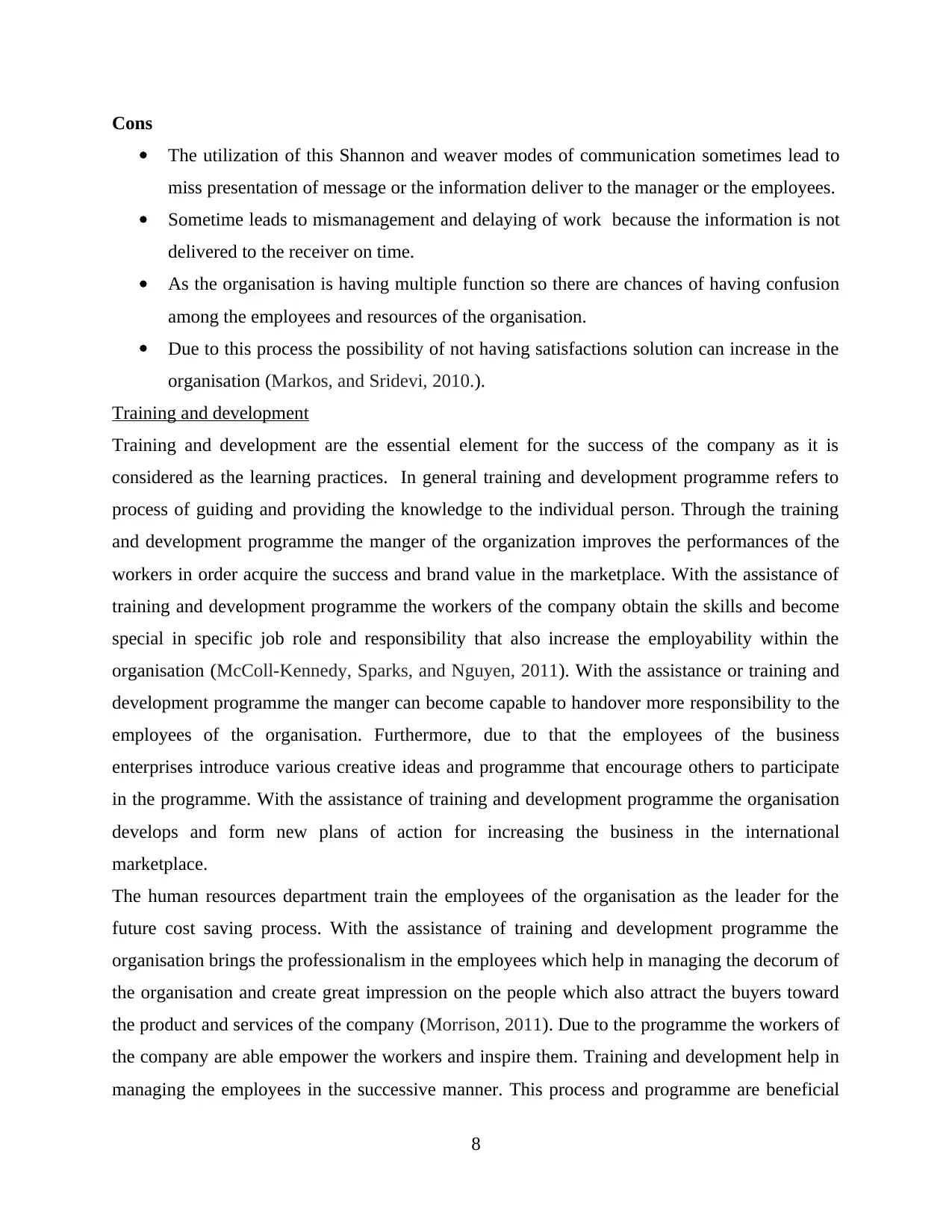
Cons
The utilization of this Shannon and weaver modes of communication sometimes lead to
miss presentation of message or the information deliver to the manager or the employees.
Sometime leads to mismanagement and delaying of work because the information is not
delivered to the receiver on time.
As the organisation is having multiple function so there are chances of having confusion
among the employees and resources of the organisation.
Due to this process the possibility of not having satisfactions solution can increase in the
organisation (Markos, and Sridevi, 2010.).
Training and development
Training and development are the essential element for the success of the company as it is
considered as the learning practices. In general training and development programme refers to
process of guiding and providing the knowledge to the individual person. Through the training
and development programme the manger of the organization improves the performances of the
workers in order acquire the success and brand value in the marketplace. With the assistance of
training and development programme the workers of the company obtain the skills and become
special in specific job role and responsibility that also increase the employability within the
organisation (McColl-Kennedy, Sparks, and Nguyen, 2011). With the assistance or training and
development programme the manger can become capable to handover more responsibility to the
employees of the organisation. Furthermore, due to that the employees of the business
enterprises introduce various creative ideas and programme that encourage others to participate
in the programme. With the assistance of training and development programme the organisation
develops and form new plans of action for increasing the business in the international
marketplace.
The human resources department train the employees of the organisation as the leader for the
future cost saving process. With the assistance of training and development programme the
organisation brings the professionalism in the employees which help in managing the decorum of
the organisation and create great impression on the people which also attract the buyers toward
the product and services of the company (Morrison, 2011). Due to the programme the workers of
the company are able empower the workers and inspire them. Training and development help in
managing the employees in the successive manner. This process and programme are beneficial
8
The utilization of this Shannon and weaver modes of communication sometimes lead to
miss presentation of message or the information deliver to the manager or the employees.
Sometime leads to mismanagement and delaying of work because the information is not
delivered to the receiver on time.
As the organisation is having multiple function so there are chances of having confusion
among the employees and resources of the organisation.
Due to this process the possibility of not having satisfactions solution can increase in the
organisation (Markos, and Sridevi, 2010.).
Training and development
Training and development are the essential element for the success of the company as it is
considered as the learning practices. In general training and development programme refers to
process of guiding and providing the knowledge to the individual person. Through the training
and development programme the manger of the organization improves the performances of the
workers in order acquire the success and brand value in the marketplace. With the assistance of
training and development programme the workers of the company obtain the skills and become
special in specific job role and responsibility that also increase the employability within the
organisation (McColl-Kennedy, Sparks, and Nguyen, 2011). With the assistance or training and
development programme the manger can become capable to handover more responsibility to the
employees of the organisation. Furthermore, due to that the employees of the business
enterprises introduce various creative ideas and programme that encourage others to participate
in the programme. With the assistance of training and development programme the organisation
develops and form new plans of action for increasing the business in the international
marketplace.
The human resources department train the employees of the organisation as the leader for the
future cost saving process. With the assistance of training and development programme the
organisation brings the professionalism in the employees which help in managing the decorum of
the organisation and create great impression on the people which also attract the buyers toward
the product and services of the company (Morrison, 2011). Due to the programme the workers of
the company are able empower the workers and inspire them. Training and development help in
managing the employees in the successive manner. This process and programme are beneficial
8
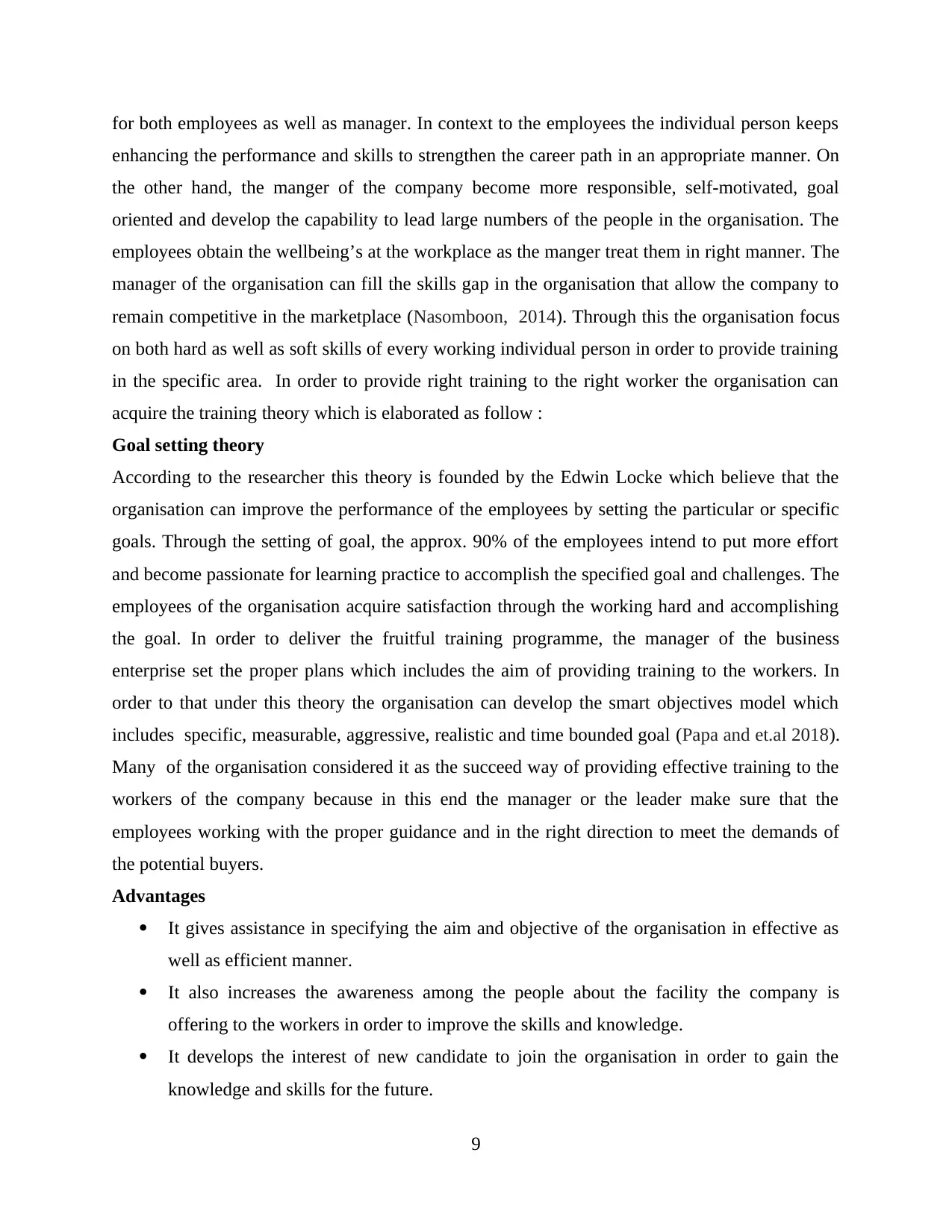
for both employees as well as manager. In context to the employees the individual person keeps
enhancing the performance and skills to strengthen the career path in an appropriate manner. On
the other hand, the manger of the company become more responsible, self-motivated, goal
oriented and develop the capability to lead large numbers of the people in the organisation. The
employees obtain the wellbeing’s at the workplace as the manger treat them in right manner. The
manager of the organisation can fill the skills gap in the organisation that allow the company to
remain competitive in the marketplace (Nasomboon, 2014). Through this the organisation focus
on both hard as well as soft skills of every working individual person in order to provide training
in the specific area. In order to provide right training to the right worker the organisation can
acquire the training theory which is elaborated as follow :
Goal setting theory
According to the researcher this theory is founded by the Edwin Locke which believe that the
organisation can improve the performance of the employees by setting the particular or specific
goals. Through the setting of goal, the approx. 90% of the employees intend to put more effort
and become passionate for learning practice to accomplish the specified goal and challenges. The
employees of the organisation acquire satisfaction through the working hard and accomplishing
the goal. In order to deliver the fruitful training programme, the manager of the business
enterprise set the proper plans which includes the aim of providing training to the workers. In
order to that under this theory the organisation can develop the smart objectives model which
includes specific, measurable, aggressive, realistic and time bounded goal (Papa and et.al 2018).
Many of the organisation considered it as the succeed way of providing effective training to the
workers of the company because in this end the manager or the leader make sure that the
employees working with the proper guidance and in the right direction to meet the demands of
the potential buyers.
Advantages
It gives assistance in specifying the aim and objective of the organisation in effective as
well as efficient manner.
It also increases the awareness among the people about the facility the company is
offering to the workers in order to improve the skills and knowledge.
It develops the interest of new candidate to join the organisation in order to gain the
knowledge and skills for the future.
9
enhancing the performance and skills to strengthen the career path in an appropriate manner. On
the other hand, the manger of the company become more responsible, self-motivated, goal
oriented and develop the capability to lead large numbers of the people in the organisation. The
employees obtain the wellbeing’s at the workplace as the manger treat them in right manner. The
manager of the organisation can fill the skills gap in the organisation that allow the company to
remain competitive in the marketplace (Nasomboon, 2014). Through this the organisation focus
on both hard as well as soft skills of every working individual person in order to provide training
in the specific area. In order to provide right training to the right worker the organisation can
acquire the training theory which is elaborated as follow :
Goal setting theory
According to the researcher this theory is founded by the Edwin Locke which believe that the
organisation can improve the performance of the employees by setting the particular or specific
goals. Through the setting of goal, the approx. 90% of the employees intend to put more effort
and become passionate for learning practice to accomplish the specified goal and challenges. The
employees of the organisation acquire satisfaction through the working hard and accomplishing
the goal. In order to deliver the fruitful training programme, the manager of the business
enterprise set the proper plans which includes the aim of providing training to the workers. In
order to that under this theory the organisation can develop the smart objectives model which
includes specific, measurable, aggressive, realistic and time bounded goal (Papa and et.al 2018).
Many of the organisation considered it as the succeed way of providing effective training to the
workers of the company because in this end the manager or the leader make sure that the
employees working with the proper guidance and in the right direction to meet the demands of
the potential buyers.
Advantages
It gives assistance in specifying the aim and objective of the organisation in effective as
well as efficient manner.
It also increases the awareness among the people about the facility the company is
offering to the workers in order to improve the skills and knowledge.
It develops the interest of new candidate to join the organisation in order to gain the
knowledge and skills for the future.
9
⊘ This is a preview!⊘
Do you want full access?
Subscribe today to unlock all pages.

Trusted by 1+ million students worldwide
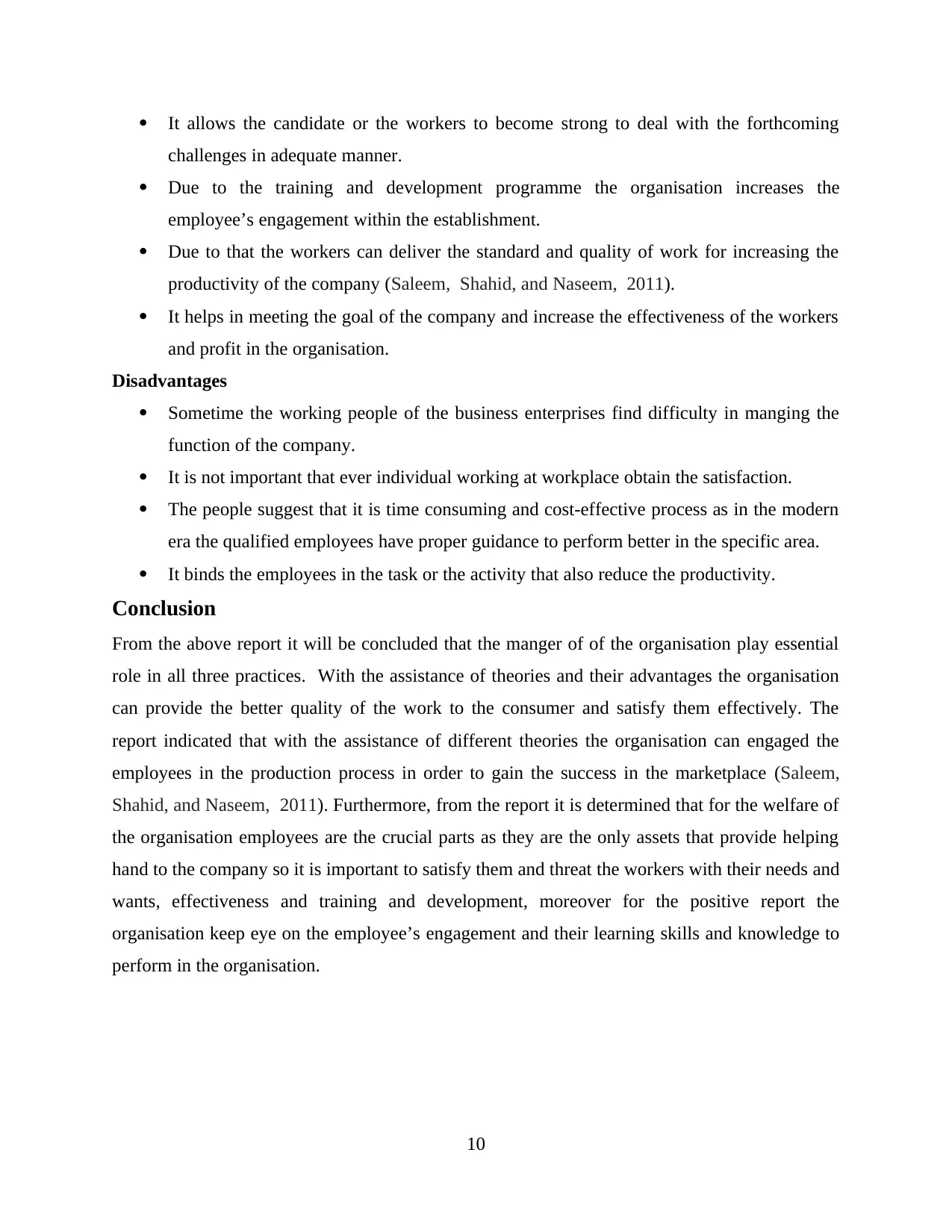
It allows the candidate or the workers to become strong to deal with the forthcoming
challenges in adequate manner.
Due to the training and development programme the organisation increases the
employee’s engagement within the establishment.
Due to that the workers can deliver the standard and quality of work for increasing the
productivity of the company (Saleem, Shahid, and Naseem, 2011).
It helps in meeting the goal of the company and increase the effectiveness of the workers
and profit in the organisation.
Disadvantages
Sometime the working people of the business enterprises find difficulty in manging the
function of the company.
It is not important that ever individual working at workplace obtain the satisfaction.
The people suggest that it is time consuming and cost-effective process as in the modern
era the qualified employees have proper guidance to perform better in the specific area.
It binds the employees in the task or the activity that also reduce the productivity.
Conclusion
From the above report it will be concluded that the manger of of the organisation play essential
role in all three practices. With the assistance of theories and their advantages the organisation
can provide the better quality of the work to the consumer and satisfy them effectively. The
report indicated that with the assistance of different theories the organisation can engaged the
employees in the production process in order to gain the success in the marketplace (Saleem,
Shahid, and Naseem, 2011). Furthermore, from the report it is determined that for the welfare of
the organisation employees are the crucial parts as they are the only assets that provide helping
hand to the company so it is important to satisfy them and threat the workers with their needs and
wants, effectiveness and training and development, moreover for the positive report the
organisation keep eye on the employee’s engagement and their learning skills and knowledge to
perform in the organisation.
10
challenges in adequate manner.
Due to the training and development programme the organisation increases the
employee’s engagement within the establishment.
Due to that the workers can deliver the standard and quality of work for increasing the
productivity of the company (Saleem, Shahid, and Naseem, 2011).
It helps in meeting the goal of the company and increase the effectiveness of the workers
and profit in the organisation.
Disadvantages
Sometime the working people of the business enterprises find difficulty in manging the
function of the company.
It is not important that ever individual working at workplace obtain the satisfaction.
The people suggest that it is time consuming and cost-effective process as in the modern
era the qualified employees have proper guidance to perform better in the specific area.
It binds the employees in the task or the activity that also reduce the productivity.
Conclusion
From the above report it will be concluded that the manger of of the organisation play essential
role in all three practices. With the assistance of theories and their advantages the organisation
can provide the better quality of the work to the consumer and satisfy them effectively. The
report indicated that with the assistance of different theories the organisation can engaged the
employees in the production process in order to gain the success in the marketplace (Saleem,
Shahid, and Naseem, 2011). Furthermore, from the report it is determined that for the welfare of
the organisation employees are the crucial parts as they are the only assets that provide helping
hand to the company so it is important to satisfy them and threat the workers with their needs and
wants, effectiveness and training and development, moreover for the positive report the
organisation keep eye on the employee’s engagement and their learning skills and knowledge to
perform in the organisation.
10
Paraphrase This Document
Need a fresh take? Get an instant paraphrase of this document with our AI Paraphraser
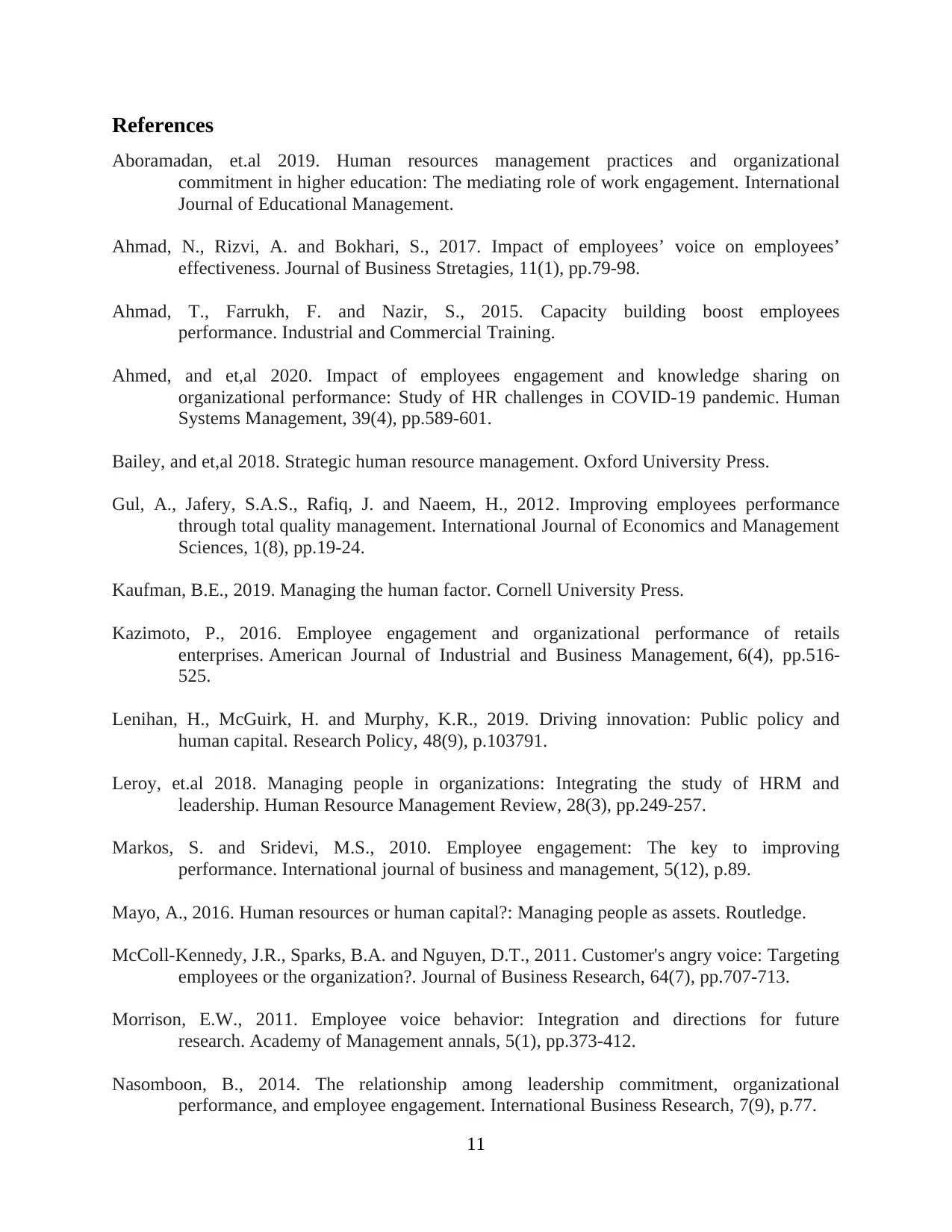
References
Aboramadan, et.al 2019. Human resources management practices and organizational
commitment in higher education: The mediating role of work engagement. International
Journal of Educational Management.
Ahmad, N., Rizvi, A. and Bokhari, S., 2017. Impact of employees’ voice on employees’
effectiveness. Journal of Business Stretagies, 11(1), pp.79-98.
Ahmad, T., Farrukh, F. and Nazir, S., 2015. Capacity building boost employees
performance. Industrial and Commercial Training.
Ahmed, and et,al 2020. Impact of employees engagement and knowledge sharing on
organizational performance: Study of HR challenges in COVID-19 pandemic. Human
Systems Management, 39(4), pp.589-601.
Bailey, and et,al 2018. Strategic human resource management. Oxford University Press.
Gul, A., Jafery, S.A.S., Rafiq, J. and Naeem, H., 2012. Improving employees performance
through total quality management. International Journal of Economics and Management
Sciences, 1(8), pp.19-24.
Kaufman, B.E., 2019. Managing the human factor. Cornell University Press.
Kazimoto, P., 2016. Employee engagement and organizational performance of retails
enterprises. American Journal of Industrial and Business Management, 6(4), pp.516-
525.
Lenihan, H., McGuirk, H. and Murphy, K.R., 2019. Driving innovation: Public policy and
human capital. Research Policy, 48(9), p.103791.
Leroy, et.al 2018. Managing people in organizations: Integrating the study of HRM and
leadership. Human Resource Management Review, 28(3), pp.249-257.
Markos, S. and Sridevi, M.S., 2010. Employee engagement: The key to improving
performance. International journal of business and management, 5(12), p.89.
Mayo, A., 2016. Human resources or human capital?: Managing people as assets. Routledge.
McColl-Kennedy, J.R., Sparks, B.A. and Nguyen, D.T., 2011. Customer's angry voice: Targeting
employees or the organization?. Journal of Business Research, 64(7), pp.707-713.
Morrison, E.W., 2011. Employee voice behavior: Integration and directions for future
research. Academy of Management annals, 5(1), pp.373-412.
Nasomboon, B., 2014. The relationship among leadership commitment, organizational
performance, and employee engagement. International Business Research, 7(9), p.77.
11
Aboramadan, et.al 2019. Human resources management practices and organizational
commitment in higher education: The mediating role of work engagement. International
Journal of Educational Management.
Ahmad, N., Rizvi, A. and Bokhari, S., 2017. Impact of employees’ voice on employees’
effectiveness. Journal of Business Stretagies, 11(1), pp.79-98.
Ahmad, T., Farrukh, F. and Nazir, S., 2015. Capacity building boost employees
performance. Industrial and Commercial Training.
Ahmed, and et,al 2020. Impact of employees engagement and knowledge sharing on
organizational performance: Study of HR challenges in COVID-19 pandemic. Human
Systems Management, 39(4), pp.589-601.
Bailey, and et,al 2018. Strategic human resource management. Oxford University Press.
Gul, A., Jafery, S.A.S., Rafiq, J. and Naeem, H., 2012. Improving employees performance
through total quality management. International Journal of Economics and Management
Sciences, 1(8), pp.19-24.
Kaufman, B.E., 2019. Managing the human factor. Cornell University Press.
Kazimoto, P., 2016. Employee engagement and organizational performance of retails
enterprises. American Journal of Industrial and Business Management, 6(4), pp.516-
525.
Lenihan, H., McGuirk, H. and Murphy, K.R., 2019. Driving innovation: Public policy and
human capital. Research Policy, 48(9), p.103791.
Leroy, et.al 2018. Managing people in organizations: Integrating the study of HRM and
leadership. Human Resource Management Review, 28(3), pp.249-257.
Markos, S. and Sridevi, M.S., 2010. Employee engagement: The key to improving
performance. International journal of business and management, 5(12), p.89.
Mayo, A., 2016. Human resources or human capital?: Managing people as assets. Routledge.
McColl-Kennedy, J.R., Sparks, B.A. and Nguyen, D.T., 2011. Customer's angry voice: Targeting
employees or the organization?. Journal of Business Research, 64(7), pp.707-713.
Morrison, E.W., 2011. Employee voice behavior: Integration and directions for future
research. Academy of Management annals, 5(1), pp.373-412.
Nasomboon, B., 2014. The relationship among leadership commitment, organizational
performance, and employee engagement. International Business Research, 7(9), p.77.
11
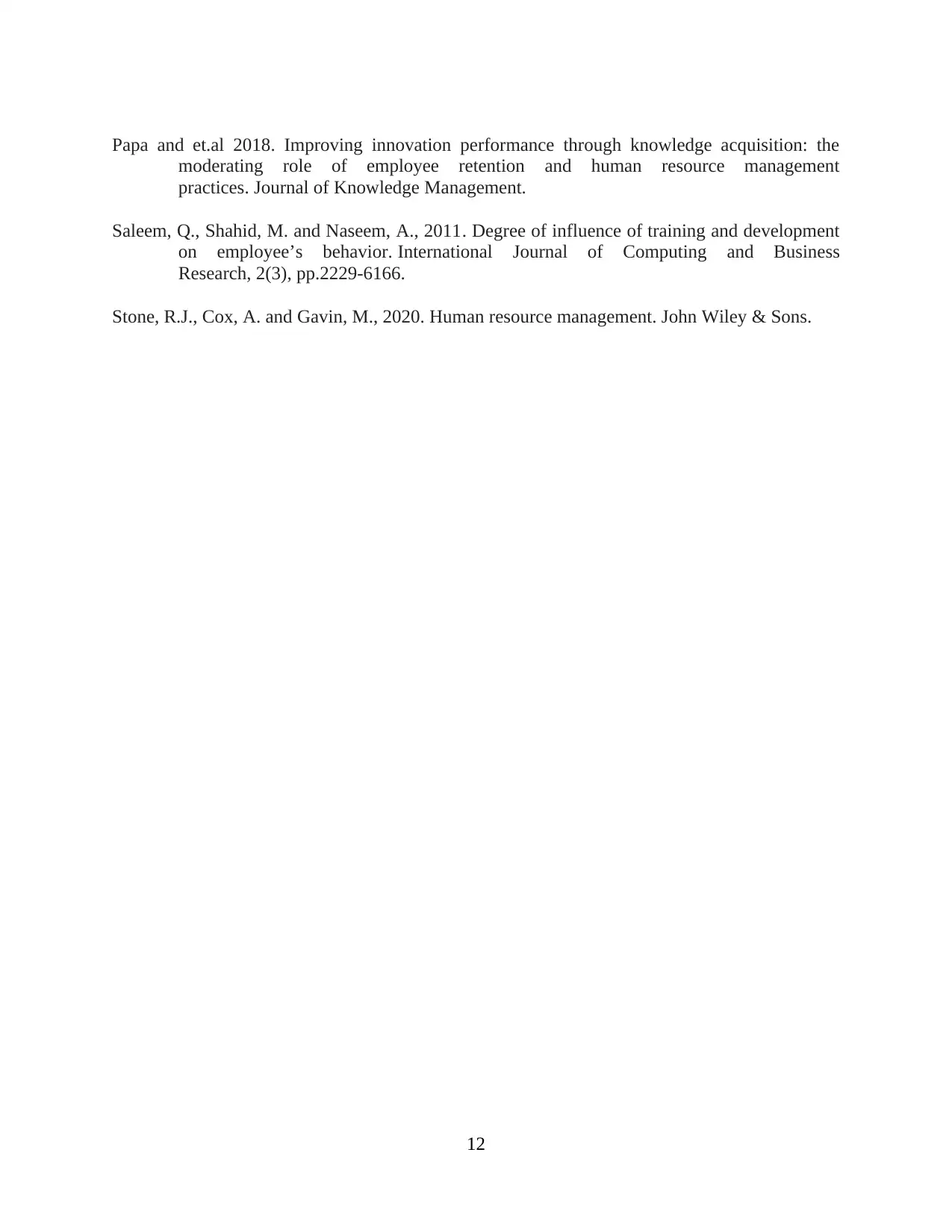
Papa and et.al 2018. Improving innovation performance through knowledge acquisition: the
moderating role of employee retention and human resource management
practices. Journal of Knowledge Management.
Saleem, Q., Shahid, M. and Naseem, A., 2011. Degree of influence of training and development
on employee’s behavior. International Journal of Computing and Business
Research, 2(3), pp.2229-6166.
Stone, R.J., Cox, A. and Gavin, M., 2020. Human resource management. John Wiley & Sons.
12
moderating role of employee retention and human resource management
practices. Journal of Knowledge Management.
Saleem, Q., Shahid, M. and Naseem, A., 2011. Degree of influence of training and development
on employee’s behavior. International Journal of Computing and Business
Research, 2(3), pp.2229-6166.
Stone, R.J., Cox, A. and Gavin, M., 2020. Human resource management. John Wiley & Sons.
12
⊘ This is a preview!⊘
Do you want full access?
Subscribe today to unlock all pages.

Trusted by 1+ million students worldwide
1 out of 12
Related Documents
Your All-in-One AI-Powered Toolkit for Academic Success.
+13062052269
info@desklib.com
Available 24*7 on WhatsApp / Email
![[object Object]](/_next/static/media/star-bottom.7253800d.svg)
Unlock your academic potential
Copyright © 2020–2025 A2Z Services. All Rights Reserved. Developed and managed by ZUCOL.



